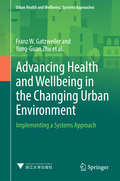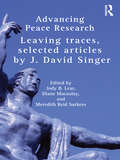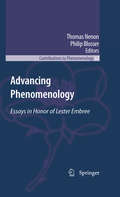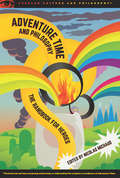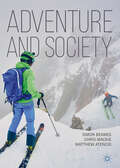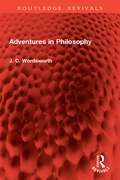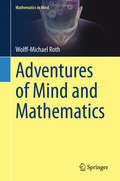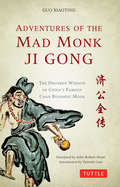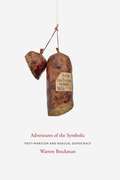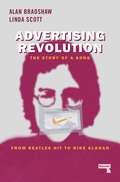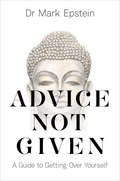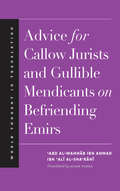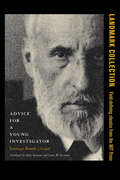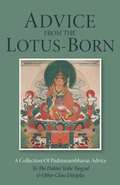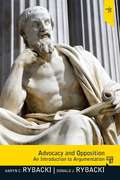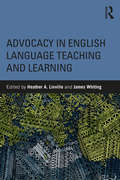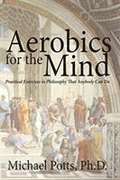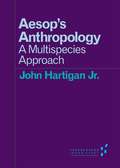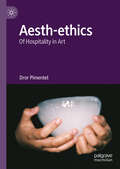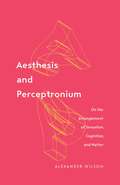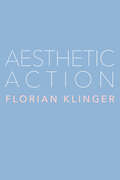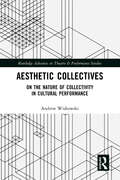- Table View
- List View
Advancing Health and Wellbeing in the Changing Urban Environment: Implementing a Systems Approach (Urban Health and Wellbeing)
by Keisuke Hanaki Franz W. Gatzweiler Yi Zhang Susan Parnell Yong-Guan Zhu Anna V. Diez Roux Anthony Capon Christel Donnelly Gérard Salem Hany M. Ayad Ilene Speizer Indira Nath Jo I. Boufford Luuk C. Rietveld Pierre Ritchie Saroj JayasingheThis book addresses up-to-date urban health issues from a systems perspective and provides an appealing integrated urban development strategy based on a 10-year global interdisciplinary research programme created by the International Council for Science (ICSU), and sponsored by the InterAcademy Partnership (IAP) and the United Nations University (UNU). The unique feature of this book is its "systems approach" to urban health and wellbeing: solution-oriented for science and society and not purely theoretical, it can be applied in the context of decision-making, and has the potential to unlock cities' unused potential by promoting health and wellbeing. Furthermore, the inter- and transdisciplinary urban issues addressed in this book are examined from a cross-sectoral perspective - e. g. the transport sector is addressed in connection with air pollution, respiratory and cardiovascular diseases and the loss of productivity. The interconnected thinking to urban health and wellbeing makes the book a particularly valuable resource. Decision makers in city administrations and civil society organizations from different geographical regions will find the book an informative and inspiring guide for delivering towards the goals of the New Urban Agenda, for which health can be the vital indicator of progress. Graduate students and researchers will be attracted by the case studies, systems methods and models provided in the book.
Advancing Peace Research: Leaving Traces, Selected Articles by J. David Singer
by J. David SingerProfessor J. David Singer has been arguably the most important influence on quantitative research into the causes and attributes of war. His pioneering work on the Correlates of War project at the University of Michigan and his numerous books and articles have inspired generations of researchers in the fields of international relations, conflict analysis, security studies and peace science. This collection is a carefully selected overview of his work which provides not only an excellent introduction to his considerable methodological, theoretical and empirical contributions but also an intellectual history of developments in the field of international relations which are reflected in Professor Singer's work. This is essential reading for all those with an interest in the use of quantitative methods in social science, the changing nature of the study of international relations and the analysis of war and peace.
Advancing Phenomenology: Essays in Honor of Lester Embree (Contributions To Phenomenology #62)
by Thomas Nenon Philip BlosserThe title Advancing Phenomenology is purposely ambiguous. On the one hand, these essays document the progress that phenomenology as an ongoing and vibrant movement has made in the period of about a century since its inception. They illustrate the advance of phenomenology both in terms of the range of topics represented in this volume and in terms of the disciplinary and geographical diversity of the scholars who have contributed to it. The topics range from scholarly appropriations of past achievements in phenomenology, to concrete phenomenological investigations into ethics and environmental philosophy, as well as phenomenological reflections on the foundations of disciplines outside philosophy such as psychology, history, the social sciences, and archeology.
Adventure Time and Philosophy
by Nicolas MichaudAdventure Time and Philosophy is a monster-beating, wild ride of philosophical mayhem. The authors have come together to understand and explore one of the deepest and most thoughtful television shows ever to assault human brain waves. Where Adventure Time shows us what the world could be like, this book screws open our cranial lids, mucks about in the mess that is our heads, and attempts to come to some answers about the nature of reality. Adventure Time challenges everything we know about life, meaning, heroism, and even burritos. And it's time to give the show some serious thought. Adventure Time and Philosophy is a chance to put down your broadsword, put your exhausted monster-slaying feet up, and try to figure out why you spend your time rescuing people in distress and fighting for justice. What is justice anyway? If you don't happen to have your pocket edition of the Enchiridion on hand, and Billy the Hero *wicked guitar solo* hasn't been returning your calls, pick up Adventure Time and Philosophy and learn what it means to be a real hero! The authors of the chapters will prove that Adventure Time is much more than a cartoon, it's a way of life. . . . It's also the future!--a post-apocalyptic future 10,000 years after the Great Mushroom War, actually. Who better to have as companions than Finn and Jake when taking on Plato, Nietzsche, and Baudrillard or encountering the Slime Princess, the Ice King, and Marceline the Vampire Queen. In a review of the show in Entertainment Weekly, Darren Franich characterized Adventure Time as a "hybrid sci-fi/fantasy/horror/musical/fairy tale, with echoes of Calvin and Hobbes, Hayao Miyazaki, Final Fantasy, Richard Linklater, Where the Wild Things Are, and the music video you made with your high school garage band." This book is filled with chapters written by a colorful cast of characters who enlighten us about the profound and life-affirming spiritual subtext and dark comedic elements of an awesomely fantastic show.
Adventure and Society
by Simon Beames Chris Mackie Matthew AtencioThis book provides a broad overview of the ways in which ‘adventurous practices’ influence, and are influenced by, the world around them. The concept of adventure is one that is too often tackled within subject silos of philosophy, education, tourism, or leisure. While much of the analysis is strong, there is little cross-pollination between disciplines. Adventure & Society pulls together the threads of these discourses into one coherent treatment of the term ‘adventure’ and the role that it plays in human social life of the 21st century. It explores how these practices can be considered more deeply through theoretical discourses of capitalism, identity construction, technology and social media, risk-taking, personal development, equalities, and sustainability. As such, the book speaks to a broad audience of undergraduate and postgraduate students across diverse subject areas, and aims to be an accessible starting point for deeper inquiry.
Adventures in Phenomenology: Gaston Bachelard (SUNY series in Contemporary French Thought)
by Eileen Rizo-Patron; Edward S. Casey; Jason M. WirthLike Schelling before him and Deleuze and Guattari after him, Gaston Bachelard made major philosophical contributions to the advancement of science and the arts. In addition to being a mathematician and epistemologist whose influential work in the philosophy of science is still being absorbed, Bachelard was also one of the most innovative thinkers on poetic creativity and its ethical implications. His approaches to literature and the arts by way of elemental reverie awakened long-buried modes of thinking that have inspired literary critics, depth psychologists, poets, and artists alike. Bachelard's extraordinary body of work, unduly neglected by the English-language reception of continental philosophy in recent decades, exhibits a capacity to speak to the full complexity and wider reaches of human thinking. The essays in this volume analyze Bachelard as a phenomenological thinker and situate his thought within the Western tradition. Considering his work alongside that of Schelling, Husserl, Bergson, Buber, Heidegger, Merleau-Ponty, Gadamer, Deleuze, and Nancy, this collection highlights some of Bachelard's most provocative proposals on questions of ontology, hermeneutics, ethics, environmental politics, spirituality, and the possibilities they offer for productive transformations of self and world.
Adventures in Philosophy (Routledge Revivals)
by J. C. WordsworthFirst published in 1925, Adventures in Philosophy presents a series of essays dealing with some of the chief problems of metaphysics and beginning with a defence of that somewhat unpopular pursuit. The first part of the book is mainly constructive in character, and not only attempts to put as clearly as possible the metaphysical views of the author but indicates their consequences from an ethical standpoint. The later chapters discuss two of the most important developments in philosophy associated with the names of Einstein and Bergson. Finally, the author considers how far religion, especially the Christian religion, is affected by the conclusions reached earlier in the book. This is an important historical reference for students and scholars of philosophy.
Adventures of Mind and Mathematics (Mathematics in Mind)
by Wolff-Michael RothThis monograph uses the concept and category of “event” in the study of mathematics as it emerges from an interaction between levels of cognition, from the bodily experiences to symbolism. It is subdivided into three parts.The first moves from a general characterization of the classical approach to mathematical cognition and mind toward laying the foundations for a view on the mathematical mind that differs from going approaches in placing primacy on events.The second articulates some common phenomena–mathematical thought, mathematical sign, mathematical form, mathematical reason and its development, and affect in mathematics–in new ways that are based on the previously developed ontology of events. The final part has more encompassing phenomena as its content, most prominently the thinking body of mathematics, the experience in and of mathematics, and the relationship between experience and mind. The volume is well-suited for anyone with a broad interest in educational theory and/or social development, or with a broad background in psychology.
Adventures of the Mad Monk Ji Gong
by Victoria Cass Guo Xiaoting John Robert ShawFollow the brilliant and hilarious adventures of a mad Zen Buddhist monk who rose from humble beginnings to become one of China's greatest folk heroes!Ji Gong studied at the great Ling Yin monastery, an immense temple that still ranges up the steep hills above Hangzhou, near Shanghai. The Chan (Zen) Buddhist masters of the temple tried to instruct Ji Gong in the spartan practices of their sect, but the young monk, following in the footsteps of other great ne'er-do-wells, distinguished himself mainly by getting expelled. He left the monastery, became a wanderer with hardly a proper piece of clothing to wear, and achieved great renown-in seedy wine shops and drinking establishments!This could have been where Ji Gong's story ended. But his unorthodox style of Buddhism soon made him a hero for popular storytellers of the Song dynasty era. Audiences delighted in tales where the mad old monk ignored-or even mocked-authority, defied common sense, never neglected the wine, yet still managed to save the day. Ji Gong remains popular in China even today, where he regularly appears as the wise old drunken fool in movies and TV shows. In Adventures of the Mad Monk Ji Gong, you'll read how he has a rogue's knack for exposing the corrupt and criminal while still pursuing the twin delights of enlightenment and intoxication. This literary classic of a traveling martial arts master, fighting evil and righting wrongs, will entertain Western readers of all ages!
Adventures of the Symbolic: Post-Marxism and Radical Democracy (Columbia Studies in Political Thought / Political History)
by Warren BreckmanMarxism's collapse in the twentieth century profoundly altered the style and substance of Western European radical thought. To build a more robust form of democratic theory and action, prominent theorists moved to reject revolution, abandon class for more fragmented models of social action, and elevate the political over the social. Acknowledging the constructedness of society and politics, they chose the "symbolic" as a concept powerful enough to reinvent leftist thought outside a Marxist framework. Following Maurice Merleau-Ponty's Adventures of the Dialectic, which reassessed philosophical Marxism at mid century, Warren Breckman critically revisits these thrilling experiments in the aftermath of Marxism.The post-Marxist idea of the symbolic is dynamic and complex, uncannily echoing the early German Romantics, who first advanced a modern conception of symbolism and the symbolic. Hegel and Marx denounced the Romantics for their otherworldly and nebulous posture, yet post-Marxist thinkers appreciated the rich potential of the ambiguities and paradoxes the Romantics first recognized. Mapping different ideas of the symbolic among contemporary thinkers, Breckman traces a fascinating reflection of Romantic themes and resonances, and he explores in depth the effort to reconcile a radical and democratic political agenda with a politics that does not privilege materialist understandings of the social. Engaging with the work of Claude Lévi-Strauss, Cornelius Castoriadis, Claude Lefort, Marcel Gauchet, Ernesto Laclau, Chantal Mouffe, and Slavoj i ek, Breckman uniquely situates these important theorists within two hundred years of European thought and extends their profound relevance to today's political activism.
Advertising Revolution: The Story of a Song, from Beatles Hit to Nike Slogan
by Linda Scott Alan BradshawThe story of "Revolution" by the Beatles, from its origin as a protest song of the 1960s, to it becoming the musical backdrop for one of the most famous, influential, and controversial adverts of all time.In 1987, Nike released their new sixty-second commercial for Air shoes—and changed the face of the advertising industry. Set to the song “Revolution” by the Beatles, the commercial was the first and only advert ever to feature an original recording of the FaUb Four. It sparked a chain of events that would transform the art of branding, the sanctity of pop music, the perception of advertisers in popular culture, and John Lennon’s place in the leftist imagination.Advertising Revolution traces the song “Revolution” from its origins in the social turmoil of the Sixties, through its controversial use in the Nike ad, to its status today as a right-wing anthem and part of Donald Trump’s campaign set list. Along the way, the book unfolds the story of how we came to think of Nike as the big bad wolf of soulless corporations, and how the Beatles got their name as the quintessential musicians of independent integrity. To what degree are each of these reputations deserved? How ruthlessly cynical was the process behind the Nike ad? And how wholesomely uncommercial was John Lennon’s writing of the song?Throughout the book, Alan Bradshaw and Linda Scott complicate our notions of commercialism and fandom, making the case for a reading of advertisements that takes into account the many overlapping intentions behind what we see onscreen. Challenging the narratives of the evil-genius ad conglomerate and the pure-intentioned artist, they argue that we can only begin to read adverts productively when we strip away the industry’s mysticism and approach advertisers and artists alike as real, flawed, differentiated human beings.
Advice Not Given: A Guide to Getting Over Yourself
by Dr EpsteinOur ego, and its accompanying sense of self-doubt, is one affliction we all share. And while our ego claims to have our best interests at heart, in its never-ending pursuit of attention and power, it sabotages the very goals it sets to achieve. In Advice Not Given, renowned psychiatrist and author Dr Mark Epstein reveals how Buddhism and Western psychotherapy both identify the ego as the limiting factor in our wellbeing and both come to the same conclusion: when we give the ego free rein, we suffer; but when it learns to let go, we are free.Our ego is at once our biggest obstacle and our greatest hope. We can be at its mercy or we can learn to mould it. Completely unique and practical, Epstein's advice can be used by all, and will provide wise counsel in a confusing world.
Advice for Callow Jurists and Gullible Mendicants on Befriending Emirs
by Adam Sabra Abd al-Wahhab al-SharaniThis mirror for princes sheds light on the relationship between spiritual and political authority in early modern Egypt This guide to political behavior and expediency offers advice to Sufi shaykhs, or spiritual guides, on how to interact and negotiate with powerful secular officials, judges, and treasurers, or emirs. Translated into English for the first time, it is a unique account of the relationship between spiritual and political authority in late medieval / early modern Islamic society.
Advice for a Young Investigator
by Santiago Ramon Y CajalAn anecdotal guide for the perplexed new investigator as well as a refreshing resource for the old pro, covering everything from valuable personality traits for an investigator to social factors conducive to scientific work.Santiago Ramón y Cajal was a mythic figure in science. Hailed as the father of modern anatomy and neurobiology, he was largely responsible for the modern conception of the brain. His groundbreaking works were New Ideas on the Structure of the Nervous System and Histology of the Nervous System in Man and Vertebrates. In addition to leaving a legacy of unparalleled scientific research, Cajal sought to educate the novice scientist about how science was done and how he thought it should be done. This recently rediscovered classic, first published in 1897, is an anecdotal guide for the perplexed new investigator as well as a refreshing resource for the old pro.Cajal was a pragmatist, aware of the pitfalls of being too idealistic—and he had a sense of humor, particularly evident in his diagnoses of various stereotypes of eccentric scientists. The book covers everything from valuable personality traits for an investigator to social factors conducive to scientific work.
Advice from the Lotus-Born
by Erik Pema Kunsang Marcia Binder Schmidt Padmasambhava Tulku Urgyen Rinpoche" Don't mistake mere words to be the meaning of the teachings. Mingle the practice with your own being and attain liberation from samsara right now." PadmasambhavaPadmasambhava is the primary master of Vajrayana, the teachings for our time. Out of his great compassion and wisdom, he instructed his main disciple Yeshe Tsogyal to conceal terma treasures to be revealed at the destined time for future practitioners. The profundity of this advice is meant to be personally applied by all individuals in all circumstances. It is a classic work, which contains valid truth for anyone who sincerely wants to follow a spiritual path."The chief compiler of Padmasambhava's teachings was Yeshe Tsogyal, an emanation of a female Buddha. There may be some people who believe that only men can attain enlightenment, but her life is proof to the opposite. The awakened state of mind is neither male or female." Tulku Urgyen Rinpoche, from Introductory Teachings
Advocacy And Opposition: An Introduction To Argumentation, Seventh Edition
by Karyn Charles Rybacki Donald Jay RybackiAdvocacy and Opposition: An Introduction to Argumentation presents a comprehensive and practical approach to argumentation and critical thinking for the beginner who needs to construct and present arguments on questions of fact, value, and policy. Advocacy and Opposition offers a theoretical view of the nature of argument in our society, a discussion of arguing as a form of communication, and a focus on how arguments are created using the Toulmin model of argument. By blending traditional and contemporary views on the nature of argument (including multicultural perspectives on the purpose and process of argument, ethics, and values), Advocacy and Opposition makes students more aware of both the development of theory and practice, providing a well-rounded approach to their study of argumentation.
Advocacy in English Language Teaching and Learning
by Heather A. Linville James WhitingAppropriate for those new to the topic and established scholars, this holistic text examines the nexus of advocacy and English-language teaching, beginning with theories of advocacy, covering constraints and challenges in practice, and offering a range of hands-on perspectives in different contexts and with different populations. Bringing together wide-ranging and diverse viewpoints in TESOL, this volume examines the role of advocacy through a social justice lens in a range of contexts, including K-12 classrooms and schools, adult and higher education settings, families and communities, and teacher-education programs and professional organizations. Advocacy in English Language Teaching and Learning offers readers a deeper understanding of what advocacy is and can be, and gives teacher candidates and educators the tools to advocate for their students, their families and communities, and their profession.
Aenesidemus of Cnossus
by Roberto PolitoThis book provides the first edition of all testimonia on the Sceptic philosopher Aenesidemus of Cnossus, deemed to be the source of Sextus Empiricus, the main representative for us of ancient Scepticism. It will be an essential reference work for all those scholars and students dealing with the history of ancient Scepticism. It provides an extensive philosophical and historical commentary, and throws light on a series of questions concerning the philosophy of the late Academy, Stoic Heracliteanism, and the interaction between medicine and philosophy in the late Hellenistic era.
Aerobics for the Mind: Practical Exercises in Philosophy that Anybody Can Do
by Michael PottsRemember when you were a child and incessantly asked your parents "Why?" You still had that childhood gift of wondering about everything from the simple "Why can't I touch the stove eye when it's red?" to the most profound questions people can ask "Why can't I see God if He's real?" <p> A common perception of philosophers is of the wizened old guru, sitting on a mountain top contemplating his navel; or worse, a stodgy, boring intellectual that everyone avoids at parties. But philosophy, at its best, is a joyous profession. Philosophers never stop wondering, why? They ask the most profound and universal questions: "Why am I here?" "Does life have a meaning?" "Is there a God?" "Do I have an immortal soul?" "What happens when I die?" Philosophers have the joy of re-living the wonder of a child. <p> Aerobics for the Mind: Practical Exercises in Philosophy that Anybody Can Do is a book for anyone who still has that unique, childlike sense of wonder.
Aesop's Anthropology: A Multispecies Approach (Forerunners: Ideas First)
by John Hartigan Jr.Aesop&’s Anthropology is a guide for thinking through the perplexing predicaments and encounters that arise as the line between human and nonhuman shifts in modern life. Recognizing that culture is not unique to humans, John Hartigan Jr. asks what we can learn about culture from other species. He pursues a variety of philosophical and scientific ideas about what it means to be social using cultural dynamics to rethink what we assume makes humans special and different from other forms of life. Through an interlinked series of brief essays, Hartigan explores how we can think differently about being human.Forerunners: Ideas First is a thought-in-process series of breakthrough digital publications. Written between fresh ideas and finished books, Forerunners draws on scholarly work initiated in notable blogs, social media, conference plenaries, journal articles, and the synergy of academic exchange. This is gray literature publishing: where intense thinking, change, and speculation take place in scholarship.
Aesth-ethics: Of Hospitality in Art
by Dror PimentelThe question of hospitality is the most pressing question in contemporary thought: How can we host that which is utterly Other, that which resists all conceptualization, and thus disrupts the proper course of thought? In the current book, the discussion of hospitality is given a new conceptualization, and extended to the field of aesthetics: the event of hospitality does not occur in the face-to-face encounter with the other person, as Emmanual Levinas conceived of it, but rather in the encounter with the work of art itself. Writing about the event of hospitality—as it is eventuated in art—involves subverting the traditional precedence of theory over practice. This subversion is also evident in the indifference to traditional distinctions, such as those between poetry and visual art; modern art and classical art; international art and local art. Moreover, most of the artworks considered throughout are hybrid in character: they are suspended in the space between the visual and the verbal, whether they involve the verbal representation of a visual object (as in Rilke’s poem “Archaic Torso of Apollo”), or a visual representation of a verbal object (as in Anselm Kiefer’s work “Your Golden Hair Margarete”). The consideration of these and other works come together to give rise to a novel and original discourse on art that is termed “Aesth-ethics,” and which is presented for the first time in this volume.
Aesthesis and Perceptronium: On the Entanglement of Sensation, Cognition, and Matter (Posthumanities #51)
by Alexander WilsonA new speculative ontology of aesthetics In Aesthesis and Perceptronium, Alexander Wilson presents a theory of materialist and posthumanist aesthetics founded on an original speculative ontology that addresses the interconnections of experience, cognition, organism, and matter. Entering the active fields of contemporary thought known as the new materialisms and realisms, Wilson argues for a rigorous redefining of the criteria that allow us to discriminate between those materials and objects where aesthesis (perception, cognition) takes place and those where it doesn&’t. Aesthesis and Perceptronium negotiates between indiscriminately pluralist views that attribute mentation to all things and eliminative views that deny the existence of mentation even in humans. By recasting aesthetic questions within the framework of &“epistemaesthetics,&” which considers cognition and aesthetics as belonging to a single category that can neither be fully disentangled nor fully reduced to either of its terms, Wilson forges a theory of nonhuman experience that avoids this untenable dilemma. Through a novel consideration of the evolutionary origins of cognition and its extension in technological developments, the investigation culminates in a rigorous reevaluation of the status of matter, information, computation, causality, and time in terms of their logical and causal engagement with the activities of human and nonhuman agents.
Aesthetic Action
by Florian KlingerIn this new book, Florian Klinger gives readers a basic action-theoretical account of the aesthetic. While normal action fulfills a determinate concept, Klinger argues, aesthetic action performs an indeterminacy by suspending the action's conceptual resolution. Taking as examples work by Tino Sehgal, Kara Walker, Mazen Kerbaj, Marina Abramović, Cy Twombly, and Franz Kafka, the book examines indeterminacy in such instances as a walk that is at once leisurely and purposeful, a sound piece that is at once joyous and mournful and mechanical, or a sculpture that at once draws one in and shuts one out. Because it has irresolution as its point, aesthetic action presents itself as an unsettling of ourselves, our ways, our very sense of who we are. As performers of such action, we don't recognize one another as bearers of a shared human form as we normally would, but find ourselves tasked anew with figuring out what sharing a form would mean. In conversation with philosophers such as Kant, Hegel, Wittgenstein, and Anscombe; political thinkers such as Marx and Lorde; and contemporary interlocutors such as Michael Thompson, Sebastian Rödl, and Thomas Khurana, Klinger's book makes a case for a conception of the human form that systematically includes the aesthetic: an actualization of the form that is indeterminate and nevertheless rational. The book gives the project of Western philosophical aesthetics a long-overdue formulation for our present that aims to do justice to contemporary aesthetic production as it actually exists. It will appeal to those working in philosophy, art, and political thought.
Aesthetic Collectives: On the Nature of Collectivity in Cultural Performance (Routledge Advances in Theatre & Performance Studies)
by Andrew WiskowskiThis book focuses attention on groups of performing people that are unique aesthetic objects, the focus of an artist’s vision, but at the same time a collective being; a singular, whole mass that exists and behaves like an individual entity. This text explores this unique experience, which is far from rare or special. Indeed, it is pervasive, ubiquitous and has, since the dawn of performance, been with us. Surveying installation art from Vanessa Beecroft & Kanye West, Greek tragedy, back-up dancing groups and even the mass dance of clubbing crowds, this text examines and names this phenomenon: Aesthetic Collectives. Drawing on a range of methods of investigation spanning performance studies, acting theory, studies of atmosphere and affect and sociology it presents an intervention in the literature for something that has long deserved its own attention. This book will be of great interest to scholars, students and practitioners in performance studies, theatre, live art, sociology (particularly of groups and subcultures), cultural studies and cultural geography.
Aesthetic Communication
by Ole ThyssenThis book deals with the organizational use of aesthetic means. Based on the idea that organizations are systems of communication, it is shown that consciously or not, organizations have always used aesthetic means to reinforce their communication.
